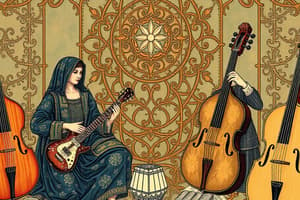Podcast
Questions and Answers
What characterizes the music of the medieval period?
What characterizes the music of the medieval period?
- The emphasis on instrumental solos accompanied by polyphony.
- The incorporation of modern time signatures and rhythms.
- The predominance of vocal music with monophonic texture. (correct)
- The use of complex harmonies and intricate melodies.
Which of the following best describes musical texture?
Which of the following best describes musical texture?
- The emotional quality conveyed by a musician's performance.
- The visual representation of sound waves in a piece of music.
- The combination of different sounds produced in a musical piece. (correct)
- The specific duration of each note played in a composition.
What is the function of a time signature in music?
What is the function of a time signature in music?
- To show the structure of a melody's notes.
- To indicate the mood or emotional tone of a piece.
- To specify the number of beats in a measure and the note value that receives one beat. (correct)
- To determine the key and scale of a musical composition.
Which note duration is considered the longest in common Western music notation?
Which note duration is considered the longest in common Western music notation?
What role does the texture of music play in a composition?
What role does the texture of music play in a composition?
Flashcards are hidden until you start studying
Study Notes
Medieval Music
- Characterized by monophony, a single melodic line without harmony
- Primarily vocal music, often used in religious settings for liturgical purposes
- Use of plainchant, a style of unaccompanied vocal music with a simple, often chant-like melody
- Development of early forms of polyphony with the addition of one or more melodic lines
- Limited use of instruments, primarily for accompanying voices or providing rhythmic support
Musical Texture
- Refers to the way different melodic and rhythmic lines interact in a musical composition
- Describes the horizontal dimension of music, focusing on the relationships between different musical parts
- Three main types:
- Monophony: single melodic line
- Homophony: one main melody with accompanying chords
- Polyphony: multiple independent melodic lines occurring simultaneously
Time Signature
- Provides information about the rhythmic structure of a piece of music
- Indicates the number of beats per measure and the type of note that receives one beat
- Helps musicians maintain a consistent tempo and rhythm throughout the composition
Note Duration
- Refers to the length of time a note is held or played
- The longest note duration in common Western music notation is the whole note, typically receiving four beats in 4/4 time
Texture of Music
- Plays a significant role in shaping the emotional impact and overall character of a composition
- Monophony can convey simplicity and solemnity, while homophony tends to create a more direct and accessible sound
- Polyphony can create a sense of complexity, counterpoint, and richness
- Texture can also influence the perception of space and movement within a musical piece
Studying That Suits You
Use AI to generate personalized quizzes and flashcards to suit your learning preferences.




